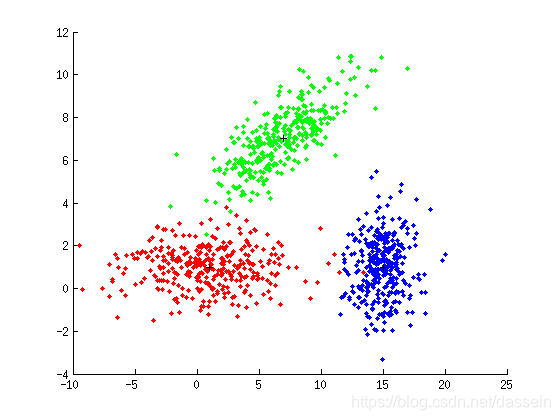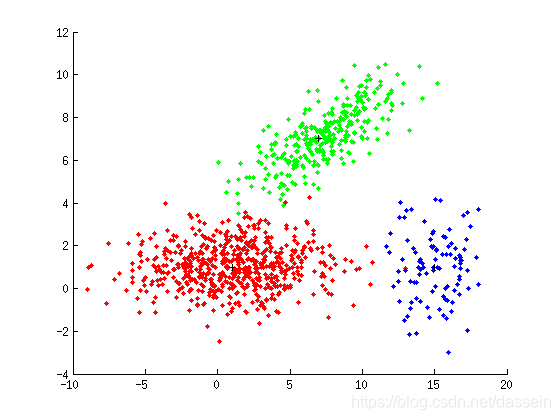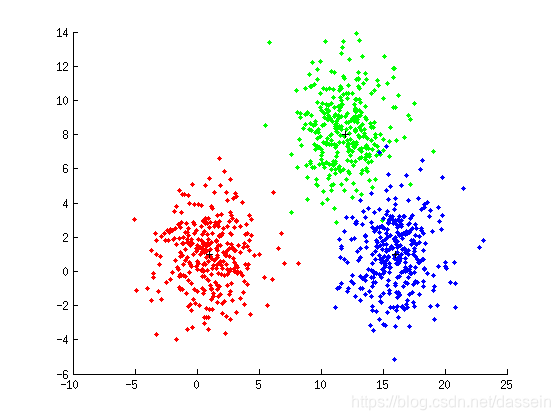Zhankun Luo
PUID: 0031195279
Email: luo333@pnw.edu
Fall-2018-ECE-59500-009
Instructor: Toma Hentea
Homework 1
文章目录
Problem
Problem 2.7
(a) classify the feature vector [1.6; 1.5]
%% Problem 2.7 : calculate parameters
sigma = [1.2 0.4; 0.4 1.8];
mu1 = [0.1; 0.1];
mu2 = [2.1; 1.9];
mu3 = [-1.5; 1.9];
w1 = sigma \ mu1;
w2 = sigma \ mu2;
w3 = sigma \ mu3;
w10 = log(1/3) - 0.5 * mu1' * w1;
w20 = log(1/3) - 0.5 * mu2' * w2;
w30 = log(1/3) - 0.5 * mu3' * w3;
%% get exact value of g_i(x) of x
x = [1.6; 1.5];
g1 = w1' * x + w10
g2 = w2' * x + w20
g3 = w3' * x + w30
result
g1 = -0.9321
g2 = 0.1279
g3 = -4.4611
conclusion
g 2 ( x ) > g 1 ( x ) ; g 2 ( x ) > g 3 ( x ) g_2(x) > g_1(x) ; g_2(x) > g_3(x) g2(x)>g1(x);g2(x)>g3(x) ==> P ( ω 2 ∣ x ) > P ( ω 1 ∣ x ) , P ( ω 3 ∣ x ) P(\omega_2|x) > P(\omega_1|x), P(\omega_3|x) P(ω2∣x)>P(ω1∣x),P(ω3∣x)
Thus x x x belongs to the second class: x → ω 2 x \rightarrow \omega_2 x→ω2
(b) draw the curves of equal Mahalanobis distance from [2.1; 1.9]
%% Problem 2.7 (b)
% draw the curves of equal Mahalanobis distance from [2.1; 1.9]
x = -2:0.2:6;
y = -2:0.2:6;
mu = [2.1; 1.9];
sigma = [1.2 0.4; 0.4 1.8];
[X,Y] = meshgrid(x,y);
vector(:, :, 1) = X - mu(1) * ones(41, 41);
vector(:, :, 2) = Y - mu(2) * ones(41, 41);
for i = 1:41
for j = 1:41
temp = vector(i, j, :);
Temp = reshape(temp, 2, 1);
tempZ = sqrt(Temp' * (sigma \ Temp));
Z(i, j) = tempZ;
end
end
figure
contour(X, Y, Z, 'ShowText', 'on')


Curves of equal Mahalanobis distance from [2.1; 1.9]
Problem 2.8
%% Problem 2.8 : calculate parameters
sigma = [0.3 0.1 0.1; 0.1 0.3 -0.1; 0.1 -0.1 0.3];
mu1 = [0; 0; 0];
mu2 = [0.5; 0.5; 0.5];
w1 = sigma \ mu1;
w2 = sigma \ mu2;
w10 = log(1/2) - 0.5 * mu1' * w1;
w20 = log(1/2) - 0.5 * mu2' * w2;
%% get coefficients of the equation describing the decision surface
w = w1 - w2
w0 = w10 - w20
result
w =
0.0000
-2.5000
-2.5000
w0 =
1.2500
conclusion
g 1 ( x ) − g 2 ( x ) = [ w 1 T x + w 10 ] − [ w 2 T x + w 20 ] = 0 g_1(x) - g_2(x) = [w_1^T x + w_{10}] - [w_2^T x + w_{20}] = 0 g1(x)−g2(x)=[w1Tx+w10]−[w2Tx+w20]=0
There w i = Σ − 1 μ i , w i 0 = l n ( P ( ω i ) ) − 1 2 μ i T Σ − 1 μ i w_i = \Sigma^{-1} \mu_i, \ w_{i0} = ln(P(\omega_i)) - \frac{1}{2}\mu_i^T \Sigma^{-1} \mu_i wi=Σ−1μi, wi0=ln(P(ωi))−21μiTΣ−1μi
g 1 ( x ) − g 2 ( x ) = ( w 1 − w 2 ) T x + [ − 0.5 μ 1 T w 1 + 0.5 μ 2 T w 2 ] + l n ( P ( ω 1 ) P ( ω 2 ) ) = 0 g_1(x) - g_2(x) = (w_1 - w_2)^T x + [- 0.5\mu_1^T w_1 + 0.5\mu_2^T w_2] + ln(\frac{P(\omega_1)}{P(\omega_2)}) = 0 g1(x)−g2(x)=(w1−w2)Tx+[−0.5μ1Tw1+0.5μ2Tw2]+ln(P(ω2)P(ω1))=0
Now ( w 1 − w 2 ) T = [ 0 , − 2.5 , − 2.5 ] , [ − 0.5 μ 1 T w 1 + 0.5 μ 2 T w 2 ] = 1.25 (w_1 - w_2)^T = [0, -2.5, -2.5], \ [- 0.5\mu_1^T w_1 + 0.5\mu_2^T w_2] = 1.25 (w1−w2)T=[0,−2.5,−2.5], [−0.5μ1Tw1+0.5μ2Tw2]=1.25
Thus, the equation describing the decision surface is
− 2.5 x 2 + ( − 2.5 ) x 3 + 1.25 + l n ( P ( ω 1 ) P ( ω 2 ) ) = 0 -2.5x_2 + (-2.5)x_3 +1.25 + ln(\frac{P(\omega_1)}{P(\omega_2)}) = 0 −2.5x2+(−2.5)x3+1.25+ln(P(ω2)P(ω1))=0
Experiment
experiment 2.1
%% Experiment 2.1
m = [ 1 7 15; 1 7 1];
S(:,:,1) = [12 0;0 1];
S(:,:,2) = [8 3;3 2];
S(:,:,3) = [2 0;0 2];
P1 = [1.0/3 1.0/3 1.0/3]'; % three equiprobable classes
P2 = [0.6 0.3 0.1]'; % a priori probabilities of the classes are given
N=1000;
%% when Vector of P = [1/3 1/3 1/3]'
[X1,y1] = gen_gauss(m,S,P1,N); figure(1); plot_data(X1,y1,m);
% title('P = [1/3; 1/3; 1/3]')
%% when Vector of P = [0.6 0.3 0.1]';
[X2,y2] = gen_gauss(m,S,P2,N); figure(2); plot_data(X2,y2,m);
% title('P = [0.6; 0.3; 0.1]')

When Vector of P = [1/3; 1/3; 1/3]

When Vector of P = [0.6; 0.3; 0.1]
experiment 2.2
%% Experiment 2.2
m=[ 1 12 16; 1 8 1];
S(:,:,1) = 4 * [1 0;0 1];
S(:,:,2) = 4 * [1 0;0 1];
S(:,:,3) = 4 * [1 0;0 1];
P = [1.0/3 1.0/3 1.0/3]';
N = 1000;
%% the Bayesian, the Euclidean, and the Mahalanobis classifiers on X
[X,y] = gen_gauss(m, S, P, N); figure(1); plot_data(X, y, m);
z = bayes_classifier(m, S, P, X);
[clas_error_bayes, percent_error] = compute_error(y, z)
z = euclidean_classifier(m, X);
[clas_error_euclidean, percent_error] = compute_error(y, z)
z = mahalanobis_classifier(m, S, X);
[clas_error_mahalanobis, percent_error] = compute_error(y, z)

result
% the Bayesian classifier
clas_error_bayes = 9
percent_error = 0.0090
% the Euclidean classifier
clas_error_euclidean = 9
percent_error = 0.0090
% the Mahalanobis classifier
clas_error_mahalanobis = 9
percent_error = 0.0090
conclusion
When
- covariance matrices S1 = S2 = S3 = kI (k>0)
- three equiprobable classes modeled by normal distributions
==> Errors of the Bayesian, the Euclidean, and the Mahalanobis classifiers Equal
experiment 2.4
%% Experiment 2.4
m=[ 1 8 13; 1 6 1];
S(:,:,1) = 6 * [1 0;0 1];
S(:,:,2) = 6 * [1 0;0 1];
S(:,:,3) = 6 * [1 0;0 1];
P = [1.0/3 1.0/3 1.0/3]';
N = 1000;
%% the Bayesian, the Euclidean, and the Mahalanobis classifiers on X
[X,y] = gen_gauss(m, S, P, N); figure(3); plot_data(X, y, m);
z = bayes_classifier(m, S, P, X);
[clas_error_bayes, percent_error] = compute_error(y, z)
z = euclidean_classifier(m, X);
[clas_error_euclidean, percent_error] = compute_error(y, z)
z = mahalanobis_classifier(m, S, X);
[clas_error_mahalanobis, percent_error] = compute_error(y, z)

result
% the Bayesian classifier
clas_error_bayes = 80
percent_error = 0.0801
% the Euclidean classifier
clas_error_euclidean = 80
percent_error = 0.0801
% the Mahalanobis classifier
clas_error_mahalanobis = 80
percent_error = 0.0801
conclusion
When centers of classes are too close: (comparing to experiment 2.4)
errors of classifiers become Larger.








 This is Zhankun Luo's homework for Pattern Recognition course Fall 2018. It covers problem sets and experiments related to feature classification, Mahalanobis distance, and classifier performance. Key findings include the classification of a feature vector, drawing Mahalanobis distance curves, and analyzing the impact of varying class parameters on classifier errors."
111793236,10293401,DS18B20温度传感器操作指南:读取与转换温度数据,"['温度传感器', 'DS18B20', '单片机编程', '嵌入式开发', '硬件接口']
This is Zhankun Luo's homework for Pattern Recognition course Fall 2018. It covers problem sets and experiments related to feature classification, Mahalanobis distance, and classifier performance. Key findings include the classification of a feature vector, drawing Mahalanobis distance curves, and analyzing the impact of varying class parameters on classifier errors."
111793236,10293401,DS18B20温度传感器操作指南:读取与转换温度数据,"['温度传感器', 'DS18B20', '单片机编程', '嵌入式开发', '硬件接口']
















 363
363

 被折叠的 条评论
为什么被折叠?
被折叠的 条评论
为什么被折叠?








